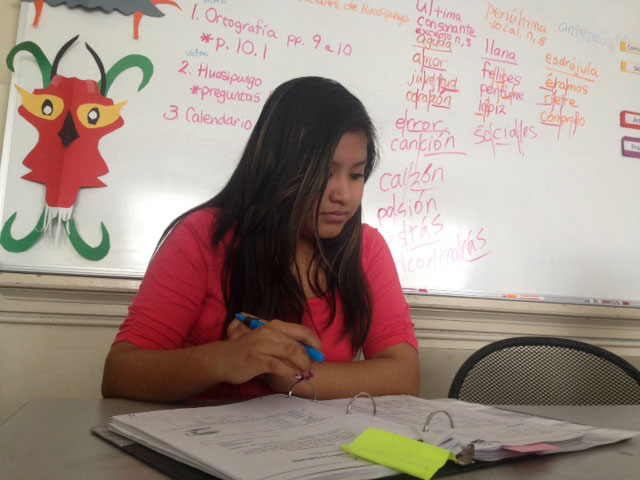Newcomer ESL program coming to South this fall
Griselda Castillo, a 14 year old Wellstone native Spanish speaker, works on vocabulary in her Spanish class. Although Wellstone’s main goal is English literacy, they also offer Native Language classes. Castillo will attend South this upcoming fall.
April 24, 2015
“I loved you. I love you. You know the next one!”
, an English Second Language (ESL) level one teacher at Wellstone high school, said encouragingly to a student working on verb tenses. “I will love you,” a 17 year old native Spanish speaker said with confidence before Persson left to work with another student.
If you enter Roosevelt high, take a right, climb a stairwell, and venture down a long hallway you will find Wellstone – a school for 16-21 year old English Language Learners (ELL) tucked away in a corner of the building.
Wellstone is a designated newcomer site, “specifically designed for recent immigrant students with limited English language proficiency,” MPS’s website explained. The majority of these 382 students current students have also arrived to the United States with little or no knowledge of the school system.
“We’re not only teaching the students the content, but teaching students who are new to the country how to actually do school.” Persson explained. This safe and sheltered transition will be changing dramatically this coming fall for about 200 Wellstone students.
Newcomers ages 14-21 have traditionally been introduced to MPS at the New Families Center, taken the W-APT english proficiency test, and were identified as Entering or Beginning (levels one and two) English learners. Most of the students labeled one and two would then attend Wellstone until reaching an Emerging level three. Level threes would then have the choice of attending a high school in their attendance area, one of the citywide secondary programs, or staying at Wellstone.
MPS will be drastically changing this process for newcomers next year. Following a district mandate, students ages 14-16 attending Wellstone will be moved into either the South or Edison buildings depending on their attendance zone. The rest, ages 17-21, will move with Wellstone to attend school in the Wilder Complex about a mile away from South.
Katie Murphy-Olsen, an ESL teacher at Wellstone, believes that this separation of older and younger students is a positive change. “I think the model is really best for students,” she stated. “Having new-to-country older students and their needs in one school will be good because we can narrow our focus.”
While older Wellstone students will remain with the majority of their peers and teachers, their younger new-to-country ESL counterparts will undergo the huge transition of immediately attending mainstream high schools. According to Wellstone’s website, there are about 216 students ages 14-16 currently enrolled.
This means that up to 100 new-to-country students could be eligible to attend South this fall if these numbers remain similar and students were divided nearly equally between South and Edison. Although this large influx of students is very possible, South staff and administration have been preparing for a much smaller group.
“I was told 30 [newcomers],” Ray Aponte, South High’s principal, said. “That’s the whole thing. We don’t really know.” Estimating newcomer enrollment at South next year is not easy. It depends on factors like the number of young ESL newcomers living in South’s attendance zone, the number changing schools after passing English Proficiency, and estimating the number of people who will move to South Minneapolis.
“I was told that [this transition] was because most of the newcomers are already in our attendance zone,” Aponte explained. “Eventually the district is going to have newcomer sites for each of those population areas… but it’s all based on geographic locations as far as I know.”
It’s nearly impossible to truly prepare for the needs of an unknown number of 14 to 16-year-old beginning English learners. Yet Aponte and the ESL staff at South are doing their best to navigate the logistics.
“[Teachers] are going to have to share [classrooms]. We know that for a fact,” Aponte said. Although this is an unpopular decision among the teaching staff, room switching and sharing throughout each school day will be necessary to make space for everyone.
Though space for this new wave of students and South’s growing population will continue to be an issue, South’s recently decided budget for the 2015-2016 school year has made staffing and resources less of a concern. “That budget thing came out pretty good, so I’m pretty excited,” Aponte stated. “The [ESL] resources are the best that I’ve seen in 20 years.”
This new budget would allow for the ESL Program at South to have seven teachers, six BPA’s or bilingual program aides, two family liaisons, $4,000 for materials and books, new curriculum, and four new iPad or Chromebook carts, just to name a few.
“We had to come up with how many teachers we needed based on the projected numbers,” said ESL teacher Nicole Schneider, as she explained how she has begun developing the plan for the ESL program for the upcoming year. “Besides just the newcomer program, we’ll also be doing co-teaching instead of having all sheltered classes,” She added about another drastic change the ESL program will undergo.
This new co-teaching model would allow for high-level (levels three-five or higher) ESL students, newcomers, and English native speakers to take integrated content area classes like science or English. Wellstone teacher Katie Olson is concerned about the huge amount of time, support, and planning that these changes to the ESL program need to succeed.
“When co-teaching at the high school level teachers need to be preparing for many classes,” Olson previously co-taught at Edison. “I had five different classes I taught throughout the day and three of them were team classes. I had to find time for collaboration and time to plan with three different teachers and in three different content areas with only one prep hour… these changes do seem really fast.”
Though planning the new co-teaching model and preparing for the newcomer programs may be difficult, Wellstone students are very excited about this transition. “[There will be] new teachers, new friends, a new experience and sports,” Griselda Castillo, an excited 14 year old from Wellstone said. “There will be soccer!”
Teachers at Wellstone are excited about the change, confident in their students ability to succeed and take advantage of opportunities at South. Some Wellstone staff members also feel anxious about their students being overlooked or unnoticed members of the South community. “Nobody is out to hurt our students obviously, but we are worried. Of course we’re worried.”
Aponte and the ESL staff are working hard to prepare as much as possible, and unite the South and Wellstone communities quickly. “[Newcomers are] going to be getting a big dose of American curriculum and exposure,” Aponte said. “I plan on working directly with that group.”
There may be many questions, concerns, and excitement about the changes, but Aponte plans to keep South as safe and focused as possible. “I’ve had a great time, I’m having fun. I want a calm predictable day for students.”






